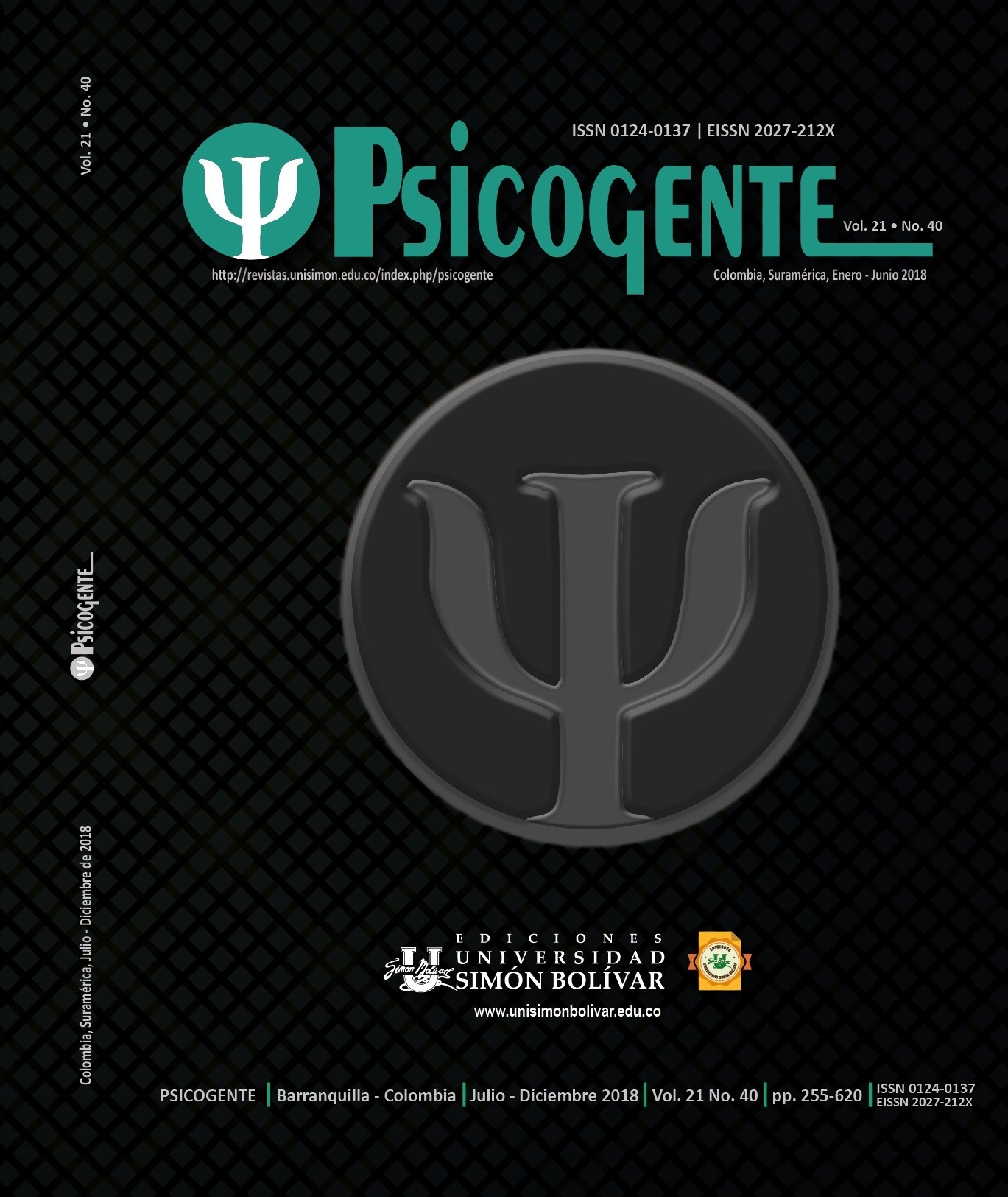Versión argentina de la escala de gratitud de Alarcón
Alarcon’s argentine gratitude scale
DOI:
https://doi.org/10.17081/psico.22.41.3309Palabras clave:
medición de la gratitud, adaptación de escala de gratitud de Alarcón, relación entre gratitud, felicidad y conducta ProsocialResumen
Objetivo: La investigación tuvo como fin la adaptación para adultos argentinos de la Escala de Gratitud de Alarcón (EG).
Método: La EG se administró a 923 participantes (65% mujeres) cuya media de edad fue de 31 años. Se separó la muestra en dos partes en forma aleatoria. Con una de las submuestras se realizó un Análisis Factorial Exploratorio (AFE) mientras que sobre la otra submuestra se corroboró la estructura hallada en el AFE mediante un Análisis Factorial Confirmatorio (AFC). El AFE se efectuó mediante el método de mínimos cuadrados no ponderados robustos para la extracción de los factores en base a la matriz de correlaciones policóricas y la implementación óptima del análisis paralelo para la determinación del número de dimensiones. El AFC también se basó en la matriz de correlaciones policóricas, estimándose los parámetros con el método de mínimos cuadrados ponderados robustos.
Resultados: Mientras que la estructura factorial de EG era tridimensional, los puntajes de la versión argentina mostraron evidencias de unidimensionalidad. Un modelo monofactorial de 12 ítems describió el 51.28% de la varianza. El alfa ordinal fue de .91. Se exploraron relaciones entre el puntaje en gratitud y las variables sociodemográficas género, edad, zona de residencia y nivel máximo de educación alcanzado. Se obtuvieron evidencias de validez convergente con la Versión Argentina de la Escala de Felicidad de Lima de Alarcón y la Escala de Conducta Prosocial de Auné, Abal y Attorresi.
Conclusiones: Se concluye que las propiedades psicométricas evidenciadas en el AFE y en el AFC así como el resultado del análisis de la validez convergente de la versión argentina de la EG resultan adecuados. Dadala relación negativa de la gratitud con el neuroticismo, la depresión y la tasa de suicidio, esta escala puede ser utilizada en intervenciones de corte clínico y psicosocial. Al ser unidimensional, el puntaje total de la escala es el puntaje en gratitud, siendo así muy sencilla para administrar y puntuar.
Descargas
Citas
Abad, F., Olea, J., Ponsoda, V., & García, C. (2011). Medición en ciencias sociales y de la salud. Madrid, España: Síntesis. URL: https://dialnet.unirioja.es/servlet/libro?-codigo=552272
Adler, M. G., & Fagley, N. S. (2005). Appreciation: Individual differences in finding value and meaning as a unique predictor of subjective well?being. Journal of Personality, 73(1), 79-114. https://doi.org/10.1111/j.1467-6494.2004.00305.x
Alarcón, R. (2006). Desarrollo de una escala factorial para medir la felicidad. Revista Interamericana de Psicología, 40(1), 95-102. URL: http://pepsic.bvsalud.org/scielo.php?script=sci_arttext&pid=S003496902006000100010&lng=pt&nrm=iso
Alarcón, R. (2014). Construcción y Valores Psicométricos de una Escala Para Medir la Gratitud. Acta de Investigación Psicológica, 4(2), 1520-1534. https://doi.org/10.1016/S2007-4719(14)70391-6
Alarcón, R. & Caycho, T. (2015). Relaciones entre gratitud y felicidad en estudiantes universitarios de Lima Metropolitana. Psychologia: Avances de la Disciplina, 9(1), 59-69. http://dx.doi.org/10.21500/19002386.993
Ato, M., López, J. J., & Benavente, A. (2013). Un sistema de clasificación de los diseños de investigación en psicología. Anales de Psicología, 29(3), 1038 - 1059. http://dx.doi.org/10.6018/analesps.29.3.178511
Auné, S. E., Abal, F. J. P., & Attorresi, H. F. (2016). Diseño y construcción de una escala de conducta prosocial para adultos. Revista Iberoamericana de Diagnóstico y Evaluación Psicológica, 42(2), 15-25. http://dx.doi.org/10.21865/RIDEP42_15
Auné, S. E., Abal, F. J. P., & Attorresi, H. F. (2017). Versión argentina de la Escala de Felicidad de Lima. Diversitas: Perspect. Psicol., 13(2), 201-214. http://dx.doi.org/10.15332/s1794-9998.2017.0002.05
Auné, S. E. & Attorresi, H. F. (2017). Dimensionalidad de un test de conducta prosocial. Evaluar, 17(1), 29-37. URL: https://revistas.unc.edu.ar/index.php/revaluar/article/view/17072
Auné, S. E., Blum, G. D., Abal, F. J. P., Lozzia, G., & Attorresi, H. F. (2014). La conducta prosocial: Estado actual de la investigación. Perspectivas en Psicología, 11(2), 21-33. URL: http://www.seadpsi.com.ar/revistas/index.php/pep/article/view/153
Badii, A., Guillen, O. P., Lugo, S., & Garnica, J. A. (2014). Correlación No-Paramétrica y su Aplicación en la Investigaciones Científica. International Journal of Good Conscience, 9(2), 31-40. URL: http://www.spentamexico.org/v9-n2/A5.9(2)31-40.pdf
Bartlett, M. Y., Condon, P., Cruz, J., Baumann, J., & Desteno, D. (2012). Gratitude: Prompting behaviours that build relationships. Cognition & Emotion, 26(1), 2-13. https://doi.org/10.1080/02699931.2011.561297
Bernabé-Valero, G., García-Alandete, J., & Gallego-Pérez, J. F. (2014). Construcción de un cuestionario para la evaluación de la gratitud: El cuestionario de Gratitud-20 ítems (G-20). Anales de Psicología, 30(1), 278-286. http://dx.doi.org/10.6018/analesps.30.1.135511
Blanca, M. J., Alarcón, R., Arnau, J., Bono, R., & Bendayan, R. (2017). Non-normal data: Is ANOVA still a valid option? Psicothema, 29(4), 552-557. http://dx.doi.org/10.7334/psicothema2016.383
Brown, T. (2015). Confirmatory factor analysis for applied research (2nd Ed.). Nueva York, Estados Unidos: Guilford Press. URL: https://www.guilford.com/books/Confirmatory-Factor-Analysis-for-Applied-Research/Timothy-Brown/9781462515363
Byrne, B. M. (2012). Structural equation modeling with Mplus: Basics, concepts, applications, and programming. Nueva York, Estados Unidos: Routledge. URL: https://www.amazon.es/Structural-Equation-Modeling-Mplus-Applications/dp/1848728395
Cárdenas Castro, M., & Arancibia Martini, H. (2014). Potencia estadística y cálculo del tamaño del efecto en G* Power: complementos a las pruebas de significación estadística y su aplicación en psicología. Salud & Sociedad, 5(2), 210-244. http://doi.org/10.22199/S07187475.2014.0002.00006
Cohen, J. (1988). Statistical Power Analysis for the Behavioral Sciences. 2nd Edit., Hillsdale, N.J., Erlbaum. Nueva York, Estados Unidos: Academic Press. URL: http://www.utstat.toronto.edu/~brunner/oldclass/378f16/readings/CohenPower.pdf
DeCarlo, L. T. (1997). On the meaning and use of kurtosis. Psychological Methods, 2(3), 292-307. http://dx.doi.org/10.1037/1082-989X.2.3.292
DeVellis, R. (2012). Scale development. Theory and applications. Nueva York, Estados Unidos: SAGE. URL: https://www.amazon.es/Scale-Development-Applications-Applied-Research/dp/1412980445
Diener, E., Emmons, R. A., Larsen, R. J., & Griffin, S. (1985). The Satisfaction with Life Scale. Journal of Personality Assessment, 49(1), 71-75. https://doi.org/10.1207/s15327752jpa4901_13
Digman, J. M. (1990). Personality structure: Emergence of the five-factor model. Annual Review of Psychology, 41(1), 417-440. https://doi.org/10.1146/annurev.ps.41.020190.002221
Disabato, D. J., Kashdan, T. B., Short, J. L., & Jarden, A. (2016). What predicts positive life events that influence the course of depression? A longitudinal examination of gratitude and meaning in life. Cognitive Therapy and Research. Advance online publication. http://dx.doi.org/10.1007/s10608-016-9785-x
Dominguez-Lara, S. (2017, en prensa). Fiabilidad y alfa ordinal. Actas Urológicas Españolas. http://dx.doi.org/10.1016/j.acuro.2017.07.002
Emmons, R. A., & McCullough, M. E. (2003). Counting blessings versus burdens: an experimental investigation of gratitude and subjective well-being in daily life. Journal of Personality and Social Psychology, 84(2), 377-389. http://dx.doi.org/10.1037/0022-3514.84.2.377
Emmons, R. A., & Mishra, A. (2011). Why gratitude enhances well- being: What we know, what we need to know. In M. Kennon, T. Sheldon, T. Kashdan, & M. F. Steger (Eds), Designing positive psychology: Taking stock and moving forward (pp. 248-264). Nueva York, Estados Unidos: Oxford Press. http://dx.doi.org/10.1093/acprof:oso/9780195373585.003.0016
Feng, E. (2011). The impact of spiritual well-being, gratitude, and loneliness on marital satisfaction among Korean American pastors and spouses. (M. S. Thesis). California State University, Long Beach. URL: https://search.proquest.com/openview/6f5e-5d9edce707b23cc55baa8a5adecc/1?pq-origsite=gscholar&cbl=18750&diss=y
Ferrando, P. J., & Anguiano-Carrasco, C. (2010). El análisis factorial como técnica de investigación en psicología. Papeles del Psicólogo, 31(1), 18-33. URL: http://www.redalyc.org/articulo.oa?id=77812441003
Ferrando, P. J., & Lorenzo-Seva, U. (2014). El análisis factorial exploratorio de los ítems: algunas consideraciones adicionales. Anales de Psicología, 30(3), 1170-1175. http://dx.doi.org/10.6018/analesps.30.3.199991
Ferrando, P. J., & Lorenzo-Seva, U. (2017). Program FACTOR at 10: Origins, development and future directions. Psicothema, 29(2), 236-240. http://dx.doi.org/10.7334/psicothema2016.304
Froh, J., Yurkewicz, Ch., & Kashdan, T. (2009). Gratitude and subjective well-being in early adolescence. Examining gender differences. Journal of Adolescence, 32(3), 633-650. http://dx.doi.org/10.1016/j.adolescence.2008.06.006
Garrido, L. E., Abad, F. J., & Ponsoda, V. (2013). A new look at Horn’s parallel analysis with ordinal variables. Psychological Methods, 18(4), 454-474. http://dx.doi.org/10.1037/a0030005
Gaskin, C. J., & Happell, B. (2014). On exploratory factor analysis: A review of recent evidence, an assessment of current practice, and recommendations for future use. International Journal of Nursing Studies, 51(3), 511-521. http://dx.doi.org/10.1016/j.ijnurstu.2013.10.005
Gil-Escudero, G., & Martínez-Arias, M. R. (2001). Metodología de encuestas. En M. J. Navas (Ed.), Métodos, diseños y técnicas de investigación psicológica (pp. 379-436). Madrid, España: Universidad Nacional de Educación a Distancia. URL:http://www.sidalc.net/cgi-bin/wxis.exe/?IsisScript=UCC.xis&method=post&formato=2&cantidad=1&expresion=mfn=135536
Gulliford, L., Morgan, B., & Kristjánsson, K. (2013). Recent work on the concept of gratitude in philosophy and psychology. Journal of Value Inquiry, 47(3), 285-317. http://dx.doi.org/10.1007/s10790-013-9387-8
Hair, J. F., Anderson, R.E., Tatham, R. L. & Black, W. C. (1999). Análisis Multivariante. Madrid, España: Prentice Hall Iberia. URL: https://wwwyyy.files.wordpress.com/2018/01/anc3a1lisis-multivariante-de-joseph-f-hair-y-otros.pdf
Hammer, J. H., & Brenner, R. E. (2017). Disentangling Gratitude: A Theoretical and Psychometric Examination of the Gratitude Resentment and Appreciation Test–Revised Short (GRAT–RS). Journal of Personality Assessment, 1-10. http://dx.doi.org/10.1080/00223891.2017.1344986
Hu, L., & Bentler, P. M. (1998). Fit indices in covariance structure modeling: sensitivity to under parameterized model misspecification. Psychological Methods, 3(4), 424-453. URL: http://psycnet.apa.org/buy/1998-11538-003
Israel-Cohen, Y., Uzefovsky, F., Kashy-Rosenbaum, G., & Kaplan, O. (2015). Gratitude and PTSD symptoms among Israeli youth exposed to missile attacks: examining the mediation of positive and negative affect and life satisfaction. The Journal of Positive Psychology, 10(2), 99-106. http://dx.doi.org/10.1080/17439760.2014.92791
Izquierdo, I., Olea, J., & Abad, F. J. (2014). Exploratory factor analysis in validation studies: Uses and recommendations. Psicothema, 26(3), 395-400. http://dx.doi.org/10.7334/psicothema2013.349
Kelley, T. L. (1935). Essential traits of mental life. Cambridge, MA: Harvard University Press.
Kleiman, E. M., Adams, L. M., Kashdan, T. B., & Riskind, J. H. (2013). Gratitude and grit indirectly reduce risk of suicidal ideations by enhancing meaning in life: Evidence for a mediated moderation model. Journal of Research in Personality, 47(5), 539-546. http://dx.doi.org/10.1016/j.jrp.2013.04.007
Joseph, S., & Wood, A. M. (2010). Assessment of positive functioning in clinical psychology: Theoretical and practical issues. Clinical Psychology Review, 30(7),830-838. http://dx.doi.org/10.1016/j.cpr.2010.01.002
Lambert, N. M., Fincham, F. D., Stillman, T. F. (2012). Gratitude and depressive symptoms: The role of positive reframing and positive emotion. Cogn. Emot. 26(4), 615–633. http://dx.doi.org/10.1080/02699931.2011.595393
León, S. & Hidalgo, E. (2017). Gratitud y felicidad en estudiantes del segundo al quinto año de una universidad privada de Lima este (Tesis para licenciatura). Universidad Peruana Unión, Lima. URL: http://repositorio.upeu.edu.pe/handle/UPEU/424
Li, S. (2015). Chinese parents’ role modeling: promoting gratitude. Childhood Education, 91(3), 190-197. http://dx.doi.org/10.1080/00094056.2015.1047310
Li, D., Zhang, W., Li, X., Li, N., & Ye, B. (2012). Gratitude and suicidal ideation and suicide attempts among Chinese Adolescents: Direct, mediated, and moderated effects. Journal of Adolescence, 35, 55-66. http://dx.doi.org/10.1016/j.adolescence.2011.06.005
Lloret-Segura, S., Ferreres-Traver, A., Hernández-Baeza, A., & Tomás-Marco, I. (2014). El análisis factorial exploratorio de los ítems: una guía práctica, revisada y actualizada. Anales de Psicología, 30(3), 1151-1169. http://dx.doi.org/10.6018/analesps.30.3.199361
Ma, L. K., Tunney, R. J., & Ferguson, E. (2017). Does gratitude enhance prosociality? A meta-analytic review. Psychological Bulletin, 143(6), 601-635. http://dx.doi.org/10.1037/bul0000103
Mardia, K. V. (1970). Measures of multivariate skewnees and kurtosis with applications. Biometrika, 57(3), 519-530. http://dx.doi.org/10.1093/biomet/57.3.519
McCullough, M. E., Emmons, R. A., & Tsang, J. A. (2002). The grateful disposition: a conceptual and empirical topography. Journal of Personality and Social Psychology, 82(1), 112-127. http://dx.doi.org/10.1037/00223514.82.1.112
Menautt Champi, C. F., Checa Cano, S. A., & Arias Gallegos, W. L. (2016). La gratitud y la percepción de equidad en el trabajo como predictores de la motivación laboral en una agencia bancaria de Arequipa. Rev. Psicol. Arequipa. Univ. Catól. San Pablo, 6(1), 67-90. URL: http://ucsp.edu.pe/investigacion/psicologia/wp-content/uploads/2017/04/Rev-psicol-UCSP-2016-1.pdf#page=67
Montero, I., & León, O. G. (2007). Sistema de clasificación del método en los informes de investigación en Psicología. International Journal of Clinical and Health Psychology, 5(1), 115-127. URL: http://www.redalyc.org/articulo.oa?id=33701007
Muthén, L. & Muthén, B. (2010). Mplus User’s Guide, 6th Edn. Los Angeles, CA: Muthén & Muthén. URL:https://www.statmodel.com/download/usersguide/Mplus%20user%20guide%20Ver_7_r6_web.pdf
Safaria, T., Diponegoro, A. M., & Bashori, K. (2017). The Efficacy of Gratitude and Forgiveness Training to Increase Happiness. The Social Sciences, 12 (11), 1948-1951. URL: http://docsdrive.com/pdfs/medwelljournals/sscience/2017/1948-1951.pdf
Tabachnick, B. & Fidell, L. (2001). Using multivariate statistics. Fourth edition. Boston: Allyn and Bacon. URL: https://trove.nla.gov.au/work/7185329
Thomas, M., & Watkins, P. (2003). Measuring the grateful trait: Development of the revised GRAT. In Poster session presented at the annual convention of the western psychological association, Vancouver, BC. http://dx.doi.org/10.13072/midss.100
Timmerman, M. E., & Lorenzo-Seva, U. (2011). Dimensionality assessment of ordered polytomous items with parallel analysis. Psychological Methods, 16, 209-220. http://dx.doi.org/10.1037/a0023353
Van Dusen, J. P., Tiamiyu, M. F., Kashdan, T. B., & Elhai, J. D. (2015). Gratitude, depression and PTSD: Assessment of structural relationships. Psychiatry Research, 230, 867-870. http://dx.doi.org/10.1016/j.psychres.2015.11.036
Watkins, P. C., Woodward, K., Stone, T., & Kolts, R. L. (2003). Gratitude and happiness: development of a measure of gratitude, and relationships with subjective well-being. Social Behavior and Personality: an International Journal, 31(21), 431-451. http://dx.doi.org/10.2224/sbp.2003.31.5.431
Watson, D., Clark, L. A., & Tellegen, A. (1988). Development and validation of brief measures of positive and negative affect: The PANAS scales. Journal of Personality and Social Psychology, 54(6), 1063-1070. URL: http://psycnet.apa.org/buy/1988-31508-001
Wood, A. M., Froh, J. J., & Geraghty, A. W. A. (2010). Gratitude and well-being: A review and theoretical integration. Clinical Psychology Review, 30(7), 890-905. http://dx.doi.org/10.1016/j.cpr.2010.03.005
Wood, A. M., Maltby, J., Gillett, R., Linley, P. A., & Joseph, S. (2008). The role of gratitude in the development of social support, stress, and depression: Two longitudinal studies. Journal of Research in Personality, 42(4), 854-871. https://doi.org/10.1016/j.jrp.2007.11.003
Yost-Dubrow, R., & Dunham, Y. (2017). Evidence for a relationship between trait gratitude and prosocial behaviour. Cognition and Emotion, 1-7. http://dx.doi.org/10.1080/02699931.2017.1289153
Publicado
Cómo citar
Número
Sección
Licencia

Esta obra está bajo una licencia internacional Creative Commons Atribución 4.0.
Desde la revista Psicogente impartimos una política de respeto con nuestra comunidad científica incluyendo a nuestros autores. Los autores tienen derecho a un trato respetuoso y atento en el proceso Editorial, que las evaluaciones de sus artículos sean justas, imparciales (para ello la revista procederá con la evaluación doble ciego) y se realicen en un tiempo razonable. Se deberá mantener la confidencialidad y los permisos para proceder con la publicación. Todo cambio solicitado por parte del comité, los pares y el Editor deberán ser explícitos y claramente justificados. Especifica que los autores/as conservarán sus derechos de autor y garantizarán a la revista el derecho de primera publicación de su obra, el cual estará simultáneamente sujeto a la Licencia de reconocimiento de Creative Commons BY que permite a terceros compartir la obra siempre que se indique su autor y su primera publicación a esta revista.
Garantizamos un proceso editorial transparente: desde las acciones de recepción del articulo hasta la validación final del mismo, se hará en comunicación constante con el autor. Las modificaciones en el estado de los artículos, así como las diversas decisiones tomadas sobre él y los tiempos de ejecución empleados se realizarán haciendo uso de la plataforma OJS y de ser necesario en contacto directo a través del correo de autores y de la revista Psicogente. Así mismo se procura la escogencia de Pares revisores idóneos: con perfiles y experiencia que lleven a una avaluación de calidad de cada documento sometido a revisión.






